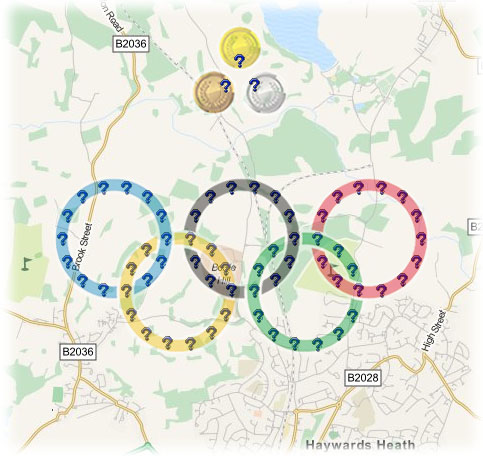
By agreement of the members of the creation team, The Sussex Olympic Rings group of 65 caches will be archived on September 19th, 2016. Thanks for your understanding.
This series of 65 puzzle caches has been placed to celebrate the London 2012 Olympics and Paralympics. Each ring is set by different cachers and contains 11 or 12 hides plus a bonus. The whole design is over 4km across. You will need to find all caches for a ring in order to find the bonus and complete the ring.
There are three Medal caches above the rings, Bronze, Silver and Gold. See the Bonus cache descriptions for how to find them. See the Gold Medal cache page for full series credits.
Note the cache is not at the published co-ordinates.
At the time of placing, the cache contains the logbook, a small pencil and sharpener (though best to bring your own pen), and a few swaps including some Olympic/Paralympic goodies!
Parking
Two significant, free, parking locations have been added as waypoints on all the Yellow Ring caches. These are not necessarily the best place to park for all the caches, but you should consider them seriously where they are reasonably near the final co-ordinates you have successfully had confirmed by GeoCheck. Where more appropriate parking locations are available, some of these have been noted as parking waypoints in Geocheck. You may be able to download these.
Please read the description below and answer the questions posed. Don't expect to find all the information you will need in the description.
Substitute the answers in the formula given to generate the co-ordinates for the final cache location. It's recommended to run the solution through Geocheck.
Goalball
Goalball is a sport for athletes with visual impairments. It is played by two teams of three using a ball with bells inside. The ball is the size of a basketball but twice the weight (around 1.25 kg). All players must have a visual impairment but, to ensure that both teams are on an equal footing, all athletes must wear black-out masks so that no player can see.
The object of the game is to throw the ball into the opposing team's net, while defenders attempt to block it with their bodies. The indoor court has tactile lines to assist players with their orientation on court and the ball must make contact with certain areas of the court during the game.
In contrast to the cheers and applause that ring out around most Paralympic Games’ venues, the Goalball arena is silent during play. This is to allow the players to hear the ball.
ParalympicsGB did not take a Goalball team to Beijing, but both the GB men’s and women’s teams have made improvements to their performance programme and move strongly towards London 2012.
The GB women's team competed in December 2011 in the London Prepares Test Event losing 1-0 to the World Champions China and 5-2 to Beijing gold medallists, USA. The GB women’s team includes teenager Georgina Bullen, who was just 14 when she won European gold in 2009 with her fellow team-mates in Munich, Germany, and Anna Sharkey, who’s brother Michael will also be targeting a place for 2012.
The men’s team is also seeking to improve their results in 2012 and has many new young talents coming through including the Knotts brothers. Team stalwart Simon Goodall has been playing the sport since 1989.
Note: Thanks go to the British Paralympic Association for the above information.
A standard game of goalball consists of 2 halves totalling how many minutes? = JK
How many shot recorders are required for goalball games? = L
How many time-outs can a team request in 1 game (excluding medical time-outs)? = M
How wide is a goal in metres? = N
A court is divided into 6 sections. What is the size of a section in square metres? = PQ
In total, how many players and substitutes are allowed on the team bench area at one time? = R
A player from team X throws a ball from the centre of the edge of the X "team" area where it meets the adjacent "landing" area. The ball travels at an average speed of 54 mph until a player from team Y stops it, right in the centre of the edge of the Y "team" area where it meets the adjacent "landing"area at the Y team end of the court. How many seconds (expressed to 1 decimal place) does it take to make impact with player Y from the moment it is released by player X? = X.Y
You would be advised to consult IBSA Goalball Rules 2010-2013 where necessary to be sure of consistency in the data you use in answering the questions as we understand these to be the rules applicable to the London 2012 Paralympics and are the source used here for the answers to the questions
N 51° 0A.BCD W 0° 0E.FGH
where
A = Q - R
B = Y - P
C = (J x K) / 2
D = M
E = Q
F = L
G = N
H = X + Y - P
